Page 4 of 341
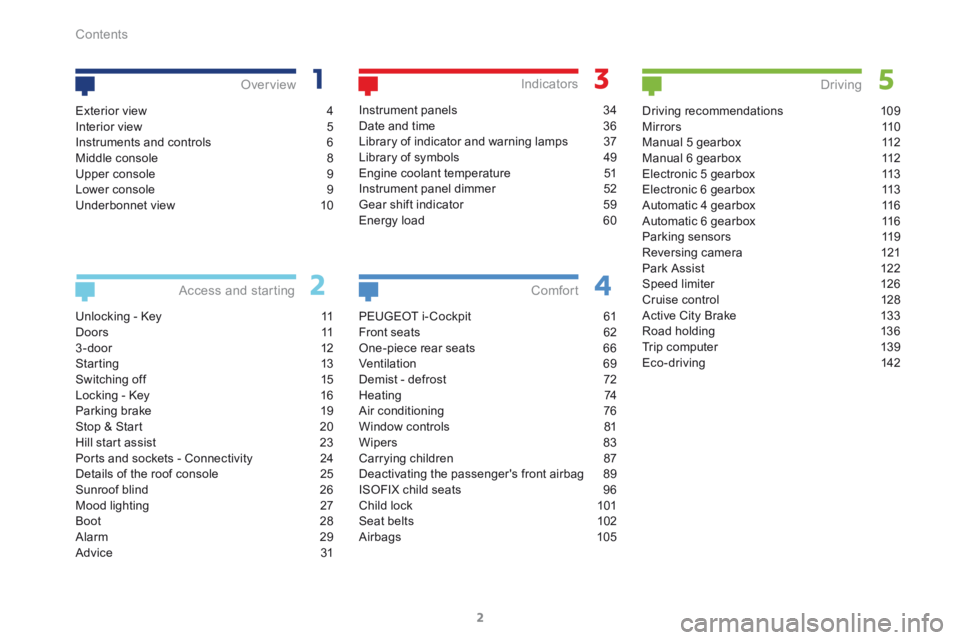
2
208_en_Chap00a_sommaire_ed01-2015
Unlocking - Key 11
D o o r s 11
3 - door 12
Starting 13
Switching off 15
Locking - Key 16
Parking brake 19
Stop & Start 20
Hill start assist 23
Ports and sockets - Connectivity 24
Details of the roof console 25
Sunroof blind 26
Mood lighting 27
Boot 28
Alarm 29
Advice 31
Access and starting Over view
Instrument panels
34
Date and time 36
Library of indicator and warning lamps 37
Library of symbols 49
Engine coolant temperature 51
Instrument panel dimmer 52
Gear shift indicator 59
Energy load 60
Indicators
PEUGEOT i- Cockpit 61
Front seats 62
One-piece rear seats 66
Ventilation 69
Demist - defrost 72
Heating 74
Air conditioning 76
Window controls 81
Wipers 83
Carrying children 87
Deactivating the passenger's front airbag 89
ISOFIX child seats 96
Child lock 101
Seat belts 102
Airbags 105
Comfort
Driving recommendations 109
M i r r o r s 11 0
Manual 5 gearbox 112
Manual 6 gearbox 112
Electronic 5 gearbox 113
Electronic 6 gearbox 113
Automatic 4 gearbox 116
Automatic 6 gearbox 116
Parking sensors 119
Reversing camera 121
Park Assist 122
Speed limiter 126
Cruise control 128
Active City Brake 133
Road holding 136
Trip computer 139
Eco-driving 142
Driving
Exterior view 4
Interior view 5
Instruments and controls 6
Middle console 8
Upper console 9
Lower console 9
Underbonnet view 10
Contents
Page 10 of 341
8
208_en_Chap01_vue-ensemble_ed01-2015
Touch screen.Heating / Ventilation.
Hazard warning lamps. Bluetooth audio system.
Audio system.
Middle console
Central locking.
Automatic dual-zone
air conditioning.
Centre console
223-285 2 87- 3 0 5
3 07- 318 74 -75
76 -77
78- 80
14 4 18
Manual air
conditioning.
Over view
Page 62 of 341
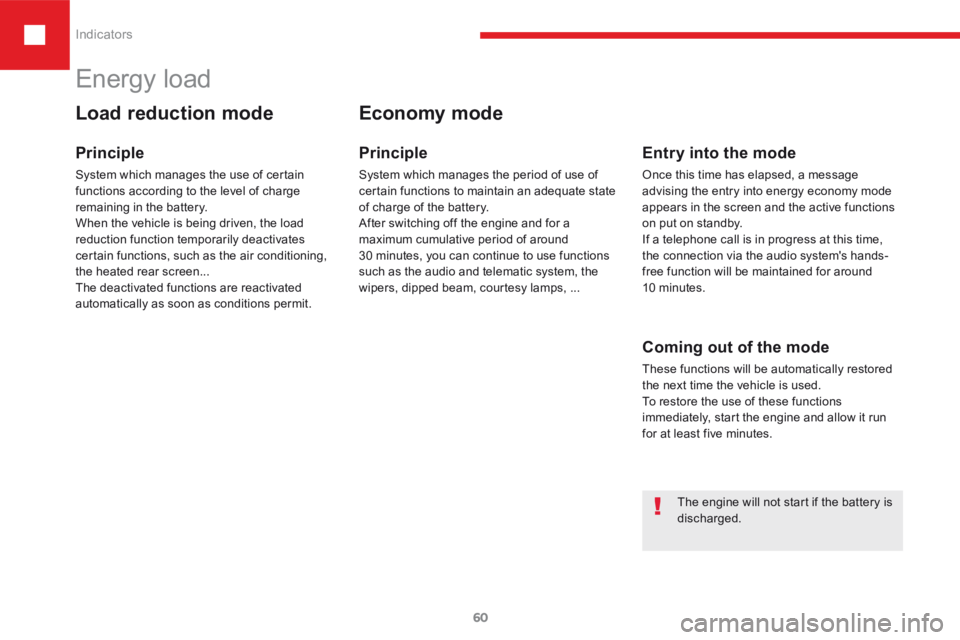
60
208_en_Chap03_Indicateurs_ed01-2015
Energy load
Load reduction mode
Principle
System which manages the use of certain
functions according to the level of charge
remaining in the battery.
When the vehicle is being driven, the load
reduction function temporarily deactivates
certain functions, such as the air conditioning,
the heated rear screen...
The deactivated functions are reactivated
automatically as soon as conditions permit.
Economy mode
Principle
System which manages the period of use of
certain functions to maintain an adequate state
of charge of the battery.
After switching off the engine and for a
maximum cumulative period of around
30 minutes, you can continue to use functions
such as the audio and telematic system, the
wipers, dipped beam, courtesy lamps, ...
Entry into the mode
Once this time has elapsed, a message
advising the entry into energy economy mode
appears in the screen and the active functions
on put on standby.
If a telephone call is in progress at this time,
the connection via the audio system's hands-
free function will be maintained for around
10 minutes.
Coming out of the mode
These functions will be automatically restored
the next time the vehicle is used.
To restore the use of these functions
immediately, start the engine and allow it run
for at least five minutes.
The engine will not start if the battery is
discharged.
Indicators
Page 71 of 341
69
208_en_Chap04_confort_ed01-2015
Ventilation
Air intake
The air circulating in the passenger
compartment is filtered and originates either
from the outside via the grille located at the
base of the windscreen or from the inside in air
recirculation mode.
Air intake flow
The incoming air follows various paths
depending on the controls selected by the
driver:
- direct arrival in the passenger
compartment (air intake),
- passage through a heating circuit (heating),
- passage through a cooling circuit (air
conditioning).
Control panel
The controls of this system are grouped
together on the control panel on the centre
console.
General points
Air distribution
The incoming air is distributed via various
outlets:
- windscreen demisting-defrosting vents,
- front side window demisting-defrosting
vents,
- side adjustable air vents,
- central adjustable air vents,
- air outlets to the front footwells,
- air outlets to the rear footwells.
4
Comfort
Page 72 of 341
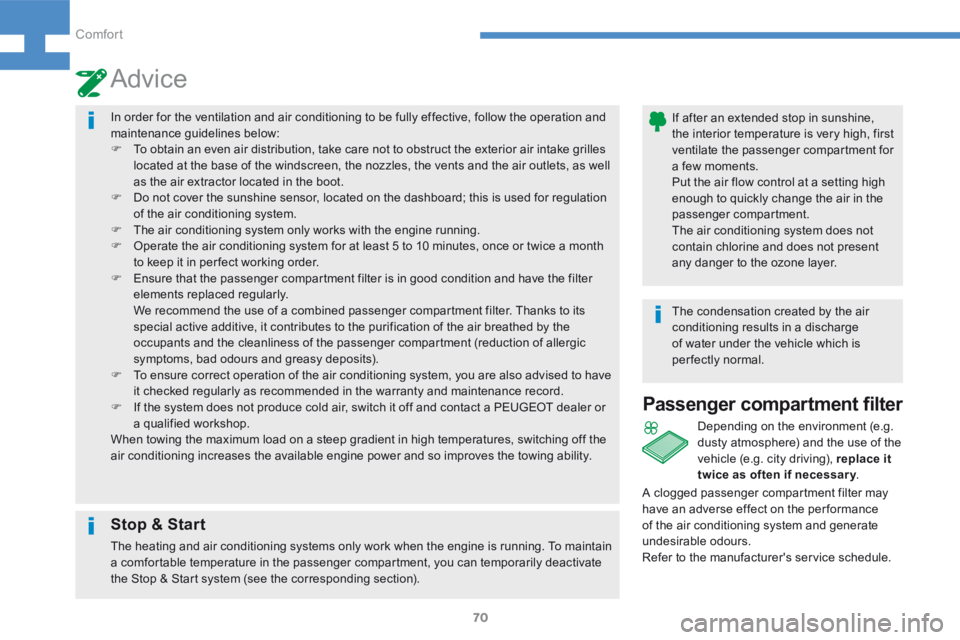
70
208_en_Chap04_confort_ed01-2015
In order for the ventilation and air conditioning to be fully effective, follow the operation and
maintenance guidelines below:
F To obtain an even air distribution, take care not to obstruct the exterior air intake grilles
located at the base of the windscreen, the nozzles, the vents and the air outlets, as well
as the air extractor located in the boot.
F Do not cover the sunshine sensor, located on the dashboard; this is used for regulation
of the air conditioning system.
F The air conditioning system only works with the engine running.
F Operate the air conditioning system for at least 5 to 10 minutes, once or twice a month
to keep it in per fect working order.
F Ensure that the passenger compartment filter is in good condition and have the filter
elements replaced regularly.
We recommend the use of a combined passenger compartment filter. Thanks to its
special active additive, it contributes to the purification of the air breathed by the
occupants and the cleanliness of the passenger compartment (reduction of allergic
symptoms, bad odours and greasy deposits).
F To ensure correct operation of the air conditioning system, you are also advised to have
it checked regularly as recommended in the warranty and maintenance record.
F If the system does not produce cold air, switch it off and contact a PEUGEOT dealer or
a qualified workshop.
When towing the maximum load on a steep gradient in high temperatures, switching off the
air conditioning increases the available engine power and so improves the towing ability.
Advice
If after an extended stop in sunshine,
the interior temperature is very high, first
ventilate the passenger compartment for
a few moments.
Put the air flow control at a setting high
enough to quickly change the air in the
passenger compartment.
The air conditioning system does not
contain chlorine and does not present
any danger to the ozone layer.
The condensation created by the air
conditioning results in a discharge
of water under the vehicle which is
perfectly normal.
Stop & Start
The heating and air conditioning systems only work when the engine is running. To maintain
a comfortable temperature in the passenger compartment, you can temporarily deactivate
the Stop & Start system (see the corresponding section).
Passenger compartment filter
Depending on the environment (e.g.
dusty atmosphere) and the use of the
vehicle (e.g. city driving), replace it
twice as often if necessar y .
A clogged passenger compartment filter may
have an adverse effect on the per formance
of the air conditioning system and generate
undesirable odours.
Refer to the manufacturer's service schedule.
Comfort
Page 73 of 341
71
208_en_Chap04_confort_ed01-2015
Advice
Digital air conditioning: use the automatic mode in preference by pressing the "AUTO" button.
I require...
Heating or Manual air conditioning
Air distribution Air flowRecirculation of interior air /
Intake of exterior air Temperature
Manual AC
HOT
COLD
DEMISTING
DEFROSTING
Interior settings
4
Comfort
Page 74 of 341
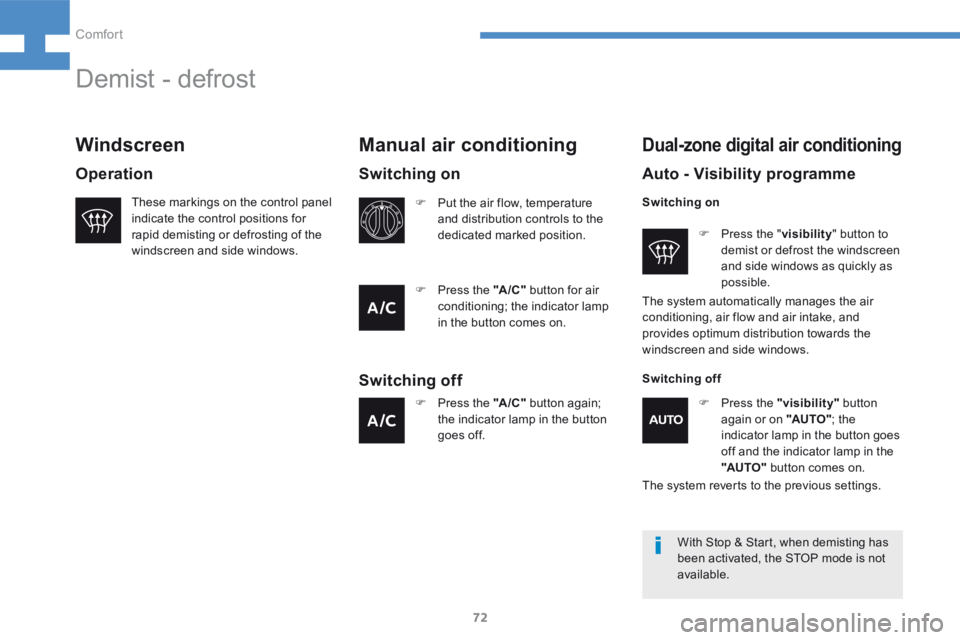
72
208_en_Chap04_confort_ed01-2015
Demist - defrost
These markings on the control panel
indicate the control positions for
rapid demisting or defrosting of the
windscreen and side windows.
Manual air conditioning
With Stop & Start, when demisting has
been activated, the STOP mode is not
available.
Dual-zone digital air conditioning
Auto - Visibility programme
Switching on
Windscreen
Operation
F Press the "A /C " button again;
the indicator lamp in the button
goes off. F
Press the "visibility" button
again or on "AUTO" ; the
indicator lamp in the button goes
off and the indicator lamp in the
"AUTO" button comes on.
Switching on
F Put the air flow, temperature
and distribution controls to the
dedicated marked position. F
Press the " visibility" button to
demist or defrost the windscreen
and side windows as quickly as
possible.
Switching off
The system automatically manages the air
conditioning, air flow and air intake, and
provides optimum distribution towards the
windscreen and side windows.
Switching off
The system reverts to the previous settings.
F
Press the "A /C " button for air
conditioning; the indicator lamp
in the button comes on.
Comfort
Page 75 of 341
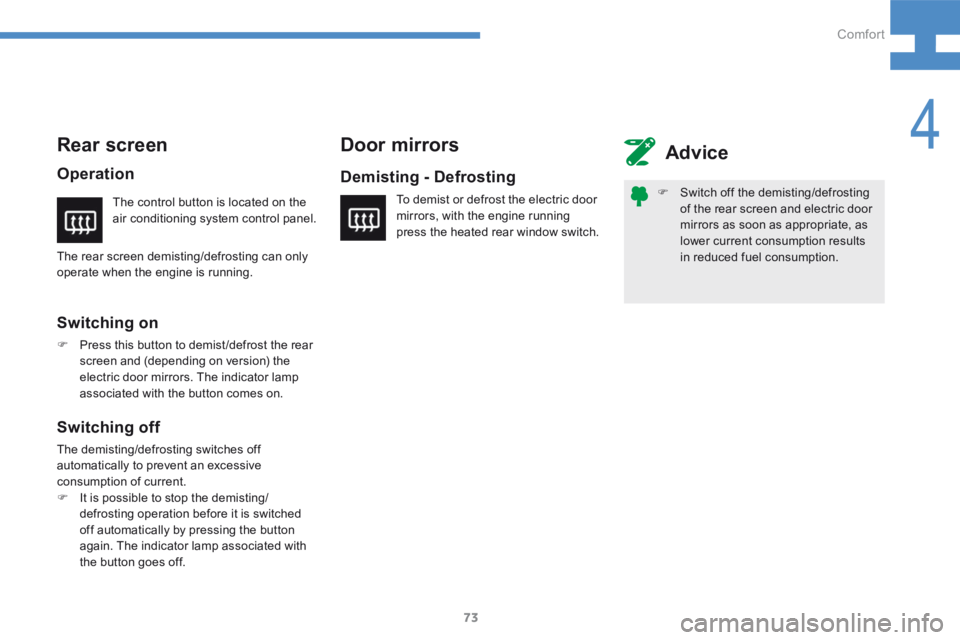
73
208_en_Chap04_confort_ed01-2015
F Switch off the demisting/defrosting
of the rear screen and electric door
mirrors as soon as appropriate, as
lower current consumption results
in reduced fuel consumption.
Advice
Door mirrors
Demisting - Defrosting
To demist or defrost the electric door
mirrors, with the engine running
press the heated rear window switch.
Rear screen
Switching on
F
Press this button to demist /defrost the rear
screen and (depending on version) the
electric door mirrors. The indicator lamp
associated with the button comes on. The control button is located on the
air conditioning system control panel.
The rear screen demisting/defrosting can only
operate when the engine is running.
Operation
Switching off
The demisting/defrosting switches off
automatically to prevent an excessive
consumption of current.
F It is possible to stop the demisting/
defrosting operation before it is switched
off automatically by pressing the button
again. The indicator lamp associated with
the button goes off.
4
Comfort